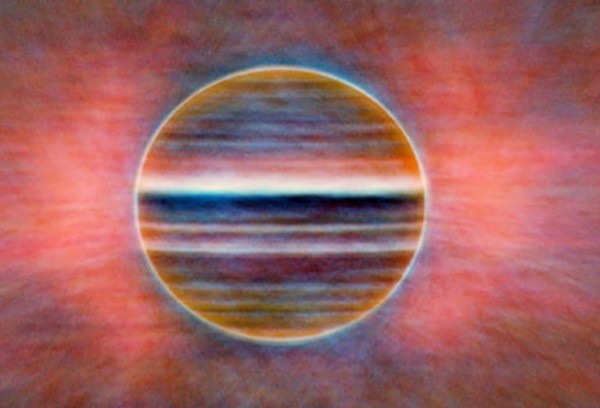New Map Shows Jupiter in Greatest Detail Yet
| Arthur Dominic Villasanta | | Jun 02, 2016 07:35 PM EDT |
(Photo : Imke de Pater, Michael H. Wong, Robert J. Sault) Radio image of Jupiter captured by the Very Large Array.
Astronomers now have a better idea of what lies underneath Jupiter's frenetic sea of clouds with a new map of this dominant feature. This map will be improved with new data from the NASA Juno spacecraft that will begin circling the planet on July 4.
A research team led by the University of California, Berkeley has produced a map of Jupiter's atmosphere down to a depth of 100 kilometers from the cloud tops that uncovers Jupiter's toxic ammonia-rich clouds and atmospheric circulation patterns in fantastic detail.
Like Us on Facebook
Using the recently upgraded Karl G. Jansky Very Large Array (VLA) radio astronomy observatory in New Mexico, the research team was able to construct a better global picture of the massive gas giant that's the largest planet in our solar system.
"The Very Large Array is about ten times more sensitive than it was before, so now we have a much higher spatial resolution," said Imke de Pater, who led the study.
"The overall dynamic picture is still correct, but now we see a lot of fine detail on that picture."
The new map reveals an active weather system in Jupiter's ammonia-rich upper atmosphere. Enormous ammonia plumes form the distinctive bands tens of thousands of kilometers across that cloak the planet.
More important, the new map might help scientists better understand what occurred in the early solar system some four billion years ago when rocky planets like Earth were first being formed into planets. Scientists said the processes that caused Jupiter to be enriched by heavier elements might also have played a key role in the formation of the Earth, Venus, and Mars.
Other scientists argue that gas giants like Jupiter are necessary for the formation of rocky planets like Earth.
"We don't know how Jupiter is enriched in heavy elements compared to the Sun, but it is," said Scott Bolton, director of NASA's Juno Mission. "And that's important, because the stuff Jupiter is enriched in is the same stuff our planet is made of."
The arrival of NASA's Juno Mission on July 4 will add immeasurably to the knowledge about Jupiter. Juno (JUpiter Near-polar Orbiter) will begin its primary science mission in November.
From its polar orbit, Juno will study Jupiter's composition, gravity field, magnetic field and polar magnetosphere. Juno will also search for clues about how Jupiter formed. It will also try to find out whether Jupiter has a rocky core and the amount of water present within the deep atmosphere.
TagsJupiter, NASA, Juno spacecraft, University of California, Berkeley, Karl G. Jansky Very Large Array
©2015 Chinatopix All rights reserved. Do not reproduce without permission
EDITOR'S PICKS
-

Did the Trump administration just announce plans for a trade war with ‘hostile’ China and Russia?
-

US Senate passes Taiwan travel bill slammed by China
-

As Yan Sihong’s family grieves, here are other Chinese students who went missing abroad. Some have never been found
-

Beijing blasts Western critics who ‘smear China’ with the term sharp power
-

China Envoy Seeks to Defuse Tensions With U.S. as a Trade War Brews
-

Singapore's Deputy PM Provides Bitcoin Vote of Confidence Amid China's Blanket Bans
-

China warns investors over risks in overseas virtual currency trading
-

Chinese government most trustworthy: survey
-

Kashima Antlers On Course For Back-To-Back Titles
MOST POPULAR
LATEST NEWS
Zhou Yongkang: China's Former Security Chief Sentenced to Life in Prison

China's former Chief of the Ministry of Public Security, Zhou Yongkang, has been given a life sentence after he was found guilty of abusing his office, bribery and deliberately ... Full Article
TRENDING STORY

China Pork Prices Expected to Stabilize As The Supplies Recover

Elephone P9000 Smartphone is now on Sale on Amazon India

There's a Big Chance Cliffhangers Won't Still Be Resolved When Grey's Anatomy Season 13 Returns

Supreme Court Ruled on Samsung vs Apple Dispute for Patent Infringement

Microsoft Surface Pro 5 Rumors and Release Date: What is the Latest?















